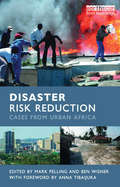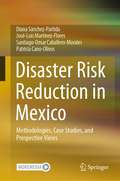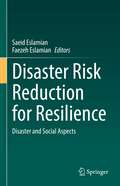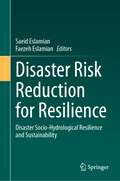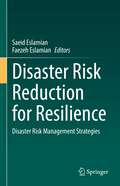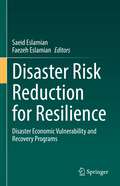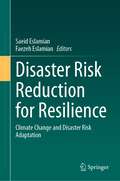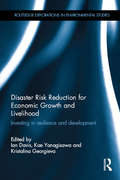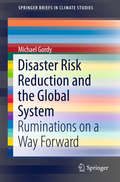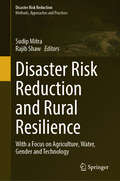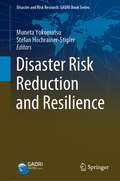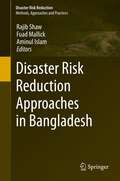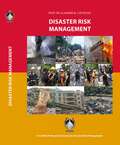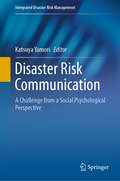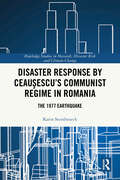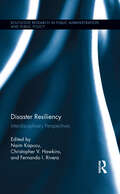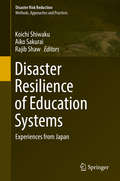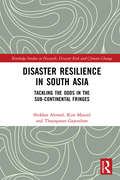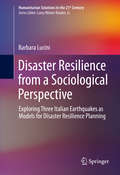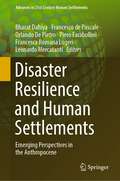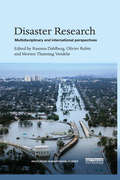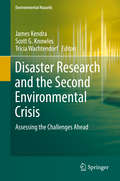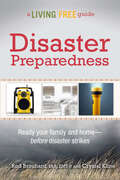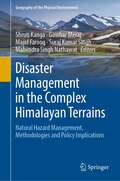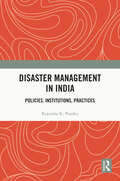- Table View
- List View
Disaster Risk Reduction: Cases from Urban Africa
by Ben Wisner Mark PellingPublished with ProVention Consortium, UNDP and UN-Habitat 'This excellent book is essential reading for those concerned with urban risk and its reduction in Africa, the most rapidly urbanizing region of the world.' Professor Jo Beall, Development Studies Institute, London School of Economics 'At last a book that recognizes the impacts of disasters on Africa's 350 million urban dwellers, including the many disasters that get overlooked and go unrecorded. But also a book that, through careful case studies, shows what creates disaster risk and what local measures can be taken to address it.' David Satterthwaite, International Institute for Environment and Development (IIED). 'This innovative volume combines the latest conceptualisations of urban disaster risk and vulnerability with case studies from across the African continent on how existing and innovative information can inform efforts to address the problems. Coverage ranges from the major catastrophes of news headlines to small, everyday disasters with which poor urban residents have to cope in their survival strategies. Written by international authorities and local specialists, this extremely useful book should find a place in the hands of academics and practitioners alike.' Professor David Simon, Department of Geography, Royal Holloway, University of London This is a one-of-a-kind book packed with original research and offering an innovative way of thinking about the reduction of risk in rapidly urbanizing cities across the globe. It is a must-have for professionals, researchers and policy makers. The book addresses four inter-related themes critical for urban risk reduction: environment; livehood; urban governance and the generation of urban risks. Its focus is on Africa, the most rapidly urbanizing world region, but it illustrates global processes. Part one reviews development, urbanization and disaster risk in Africa as a whole, identifies state-of-the-art practices and policies for building urban resilience and provides a tool kit for urban risk reduction. It also presents a powerful conceptual framework to analyse and compare disaster risk and resilience in different cities and communities. Part two presents detailed case studies from Algeria, Ghana, Senegal, Kenya, Tanzania and South Africa illustrating vulnerability to hazards ranging from earthquake to shack fire, environmental health hazards, traffic hazards and flooding. Part three looks to the future and outlines a vision for a safer urban Africa based on achieving gains in human security through inclusive governance and investment in the creative capacities of Africa's urban dwellers. With foreword by Anna Tibaijuka, Executive Director, UN-HABITAT
Disaster Risk Reduction in Mexico: Methodologies, Case Studies, and Prospective Views
by Diana Sánchez-Partida José-Luis Martínez-Flores Santiago-Omar Caballero-Morales Patricia Cano-OlivosThis book recognizes Mexico's effects and challenges in a natural disaster and offers empirical risk-reduction methods in critical cases. The proposals considered here include real and detailed analysis, a set of models, frameworks, strategies, and findings in the three stages of the disaster (before–during–after).This book:describes the methodology to find secure locations for the Regional Humanitarian Response Depot;offers recommendations for the sites and creation of an Export Logistics Cluster;shows how to use available technology and information to locate volunteers in the right spotsdescribes mathematical models to help to allocate procedure of resources for restoring the affected communityand proposes actions to create resilience in the country's main economic sectors, including agriculture and industry.The processes applied at recent disasters such as the 19S earthquake and their results are used as case studies, identifying possibilities for further improvement. The book also describes new trends for Mexico due to climate change and makes suggestions for mitigating future disasters. The proposals are also replicable to other highly populated societies with similar socio-economic structures. Finally, this book is the basis for generating more innovative recommendations by researchers, graduate students, academics, professionals, and practitioners to obtain better planning and better collaboration between all the humanitarian chain actors. This book intends to be of interest as a fundamental tool for decision-makers, governments, non-governmental organizations, and enterprises.
Disaster Risk Reduction for Resilience: Disaster and Social Aspects
by Saeid Eslamian Faezeh EslamianThis book is part of a six-volume series on Disaster Risk Reduction and Resilience. The series aims to fill in gaps in theory and practice in the Sendai Framework and provides additional resources, methodologies, and communication strategies to enhance the plan for action and targets proposed by the Sendai Framework. The series will appeal to a broad range of researchers, academics, students, policy makers, and practitioners in engineering, environmental science, geography, geoscience, emergency management, finance, community adaptation, atmospheric science and information technology.This volume provides a holistic approach to developing disaster risk reduction strategies and policies, exploring the most effective ways to integrate physical and social science aspects of hazard resilience to better inform local populations. This risk-based approach to community resilience development is used to craft a collaborative system for crisis management, and allows for the implementation of nationally determined contributions (NDCs) through social innovation and community engagement to enhance community emergency response support and preparedness. Readers will also learn about education of disaster risk reduction, human health risk assessment, gendered perspectives in disaster response, recovery, and disaster management legislation.
Disaster Risk Reduction for Resilience: Disaster Socio-Hydrological Resilience and Sustainability
by Saeid Eslamian Faezeh EslamianThis book is part of a six-volume series on Disaster Risk Reduction and Resilience. The series aims to fill in gaps in theory and practice in the Sendai Framework, and provides additional resources, methodologies and communication strategies to enhance the plan for action and targets proposed by the Sendai Framework. The series will appeal to a broad range of researchers, academics, students, policy makers and practitioners in engineering, environmental science and geography, geoscience, emergency management, finance, community adaptation, atmospheric science and information technology.This volume discusses the implementation of socio-hydrological resilience measures to curb the impacts on vulnerable communities of hydrologic diasters such as coastal floods, drought, water scarcity, and thunderstorms. The book provides a framework for sustainable hydrology-community interactions to inform local communities about the best practices to achieve hydrological resilience, and to implement resilient water infrastructure. Hydrological influences on the resilience of a region are comprehensively surveyed, and a "green economy strategy" is described and recommended for achieving climatic and hydrological sustainability.
Disaster Risk Reduction for Resilience: Disaster Risk Management Strategies
by Saeid Eslamian Faezeh EslamianThis book is part of a six-volume series on Disaster Risk Reduction and Resilience. The series aims to fill in gaps in theory and practice in the Sendai Framework, and provides additional resources, methodologies and communication strategies to enhance the plan for action and targets proposed by the Sendai Framework. The series will appeal to a broad range of researchers, academics, students, policy makers and practitioners in engineering, environmental science and geography, geoscience, emergency management, finance, community adaptation, atmospheric science and information technology. This volume offers the international guidelines and global standards for resilient disaster risk reduction and lessons learned from disasters, particularly the COVID-19 and Cholera pandemics. A resilient health system and an effective disaster risk management Index are then suggested. The book further emphasizes urban resilience strategies with local authorities, adaptation strategies for urban heat at regional, city and local scales, and lessons from community-level interventions. Also addressed are coastal erosion, displacement and resettlement strategies. Land use planning and green infrastructure are suggested as tools for natural hazards reduction. Human security in times of climate change and urban heat at regional, city and local scales is discussed for an integrated action, with case studies based in Manila, Burkina Faso, Chad, Mauritania, Niger, Senegal, Nigeria, India, Spain, and Ghana. Structure design for cascading disasters resulting from mining and flooding is presented and sustainable smart city planning using spatial data is recommended.
Disaster Risk Reduction for Resilience: Disaster Economic Vulnerability and Recovery Programs
by Saeid Eslamian Faezeh EslamianThis book is part of a six-volume series on Disaster Risk Reduction and Resilience. The series aims to fill in gaps in theory and practice in the Sendai Framework, providing additional resources, methodologies, and communication strategies to enhance the plan for action and targets proposed by the Sendai Framework. The series will appeal to a broad range of researchers, academics, students, policy makers, and practitioners in engineering, environmental science and geography, geoscience, emergency management, finance, community adaptation, atmospheric science, and information technology.This volume focuses on the concepts of economic and development vulnerability, discussing the roles of physical, social, cultural, political, economic, technological, and development factors that contribute to disaster impacts and threat levels on vulnerable populations. This approach explores how the resilience of individuals and communities can be increased in the face of future hazard threats, and how post-disaster efforts are planned for and implemented to manage risk reduction and the potential outcomes of hazard threats. Topics addressed in the boom include disaster recovery reform and resilience, recovery, and development programs, place-based reconstruction policies, resilient and sustainable disaster relief, and recovery programs, sustainable community development, and disaster recovery and post-hazard recovery strategies.
Disaster Risk Reduction for Resilience: Climate Change and Disaster Risk Adaptation
by Saeid Eslamian Faezeh EslamianThis book is part of a six-volume series on Disaster Risk Reduction and Resilience. The series aims to fill in gaps in theory and practice in the Sendai Framework, and provides additional resources, methodologies, and communication strategies to enhance the plan for action and targets proposed by the Sendai Framework. The series will appeal to a broad range of researchers, academics, students, policy makers, and practitioners in engineering, environmental science and geography, geoscience, emergency management, finance, community adaptation, atmospheric science, and information technology.This volume offers indigenous approaches to disaster risk reduction, community sustainability and climate change resilience, as well as agro-ecological innovations for improving resilience to climate change. The focus is on adaptation strategies for sustainable terrestrial and marine ecosystems to reduce the impacts of anthropogenic factors that exacerbate disaster risk, including hydro-meteorological services for climate resilience, food security measures in agriculture and livestock, flood mitigation plans, and increased climate change education and awareness. The book concludes with three case studies in Africa detailing the impacts of strengthened climate change resilience measures, adaptive social protections, and improved water availability through hydro-electric technologies.
Disaster Risk Reduction for Economic Growth and Livelihood: Investing in Resilience and Development (Routledge Explorations in Environmental Studies)
by Ian Davis Kae Yanagisawa Kristalina GeorgievaThe prevalence of natural disasters in recent years has highlighted the importance of preparing adequately for disasters and dealing efficiently with their consequences. This book addresses how countries can enhance their resilience against natural disasters and move towards economic growth and sustainable development. Covering a wide range of issues, it shows how well thought-out measures can be applied to minimize the impacts of disasters in a variety of situations. Starting with the need for coping with a rapidly changing global environment, the book goes on to demonstrate ways to strengthen awareness of the effectiveness of preventive measures, including in the reconstruction phase. The book also covers the roles played by different actors as well as tools and technologies for improved disaster risk reduction. It focuses on a variety of case studies from across Asia, Africa and Latin America, drawing out lessons that can be applied internationally. This book will be of great interest to professionals in disaster management, including national governments, donors, communities/citizens, NGOs and private sector. It will also be a highly valuable resource for students and researchers in disaster management and policy, development studies and economics.
Disaster Risk Reduction and the Global System
by Michael GordyThis short manuscript is both a distillation of some of the latest work on disaster risk reduction and an interpretation of this distillation from the author's political economic perspective. It is based on information found in the flagship reports on disaster risk reduction of the United Nations. The book sums up and interprets issues of disaster risk reduction and makes them accessible to professional and non-professional readers alike, including governmental policy makers.
Disaster Risk Reduction and Rural Resilience: With a Focus on Agriculture, Water, Gender and Technology (Disaster Risk Reduction)
by Rajib Shaw Sudip MitraEven though disaster losses frequently occur in rural and agricultural areas, a substantial number of the prevailing disaster research has focused on urban areas, often failing to notice rural populations, communities, and rural development as a whole. It is critical to assess how the needs and vulnerabilities in rural communities impact the creation of resilience, especially in countries with a large rural area. For disaster managers, rural areas present opportunities and challenges different from those of their urban counterparts. Therefore, efficient disaster risk reduction is the key to sustainable rural development. Disasters can cause human and animal life loss and the damage to field crops, stored seeds, agricultural equipment and materials, supply systems (e.g., infrastructure), livelihood, and associated indigenous knowledge. Such impacts have its short-term repercussions and affect the long-term sustainability of the rural sector. Rural regions of the developing world can be remote with high concentrations of mass poverty, food insecurity, and illiteracy; hence, access to food, shelter, and communication for relief and recovery is a challenge after a disaster. In rural areas, farmers strongly rely on natural resources and have no alternative source of income or employment, making them more vulnerable to a crisis. In addition, women are of paramount importance in rural development and agricultural activities, but they are the most affected ones during any disaster. Children and able people in the rural sector are also vulnerable; however, they have not been studied well and require more attention in days to come. This book explores the above-mentioned aspects related to disaster risk reduction, preparedness, and management in rural areas. Emerging technologies and their impacts to enhance disaster resilience in the rural sector are also illustrated. Apart from the introduction, the book has four sections focusing on 1) food and agriculture, 2) water and sanitation, 3) gender and social issues, and 4) rural technology. The book is a valuable resource material for students, researchers, academicians, policymakers, and development practitioners.
Disaster Risk Reduction and Resilience (Disaster and Risk Research: GADRI Book Series)
by Stefan Hochrainer-Stigler Muneta YokomatsuThis book provides insight on how disaster risk management can increase the resilience of society to various natural hazards. The multi-dimensionality of resilience and the various different perspectives in regards to disaster risk reduction are taken explicitly into account by providing studies and approaches on different scales and ranging from natural science based methods to social science frameworks. For all chapters, special emphasis is placed on implementation aspects and specifically in regards to the targets and priorities for action laid out in the Sendai Framework for Disaster Risk Reduction. The chapters provide also a starting point for interested readers on specific issues of resilience and therefore include extensive reference material and important future directions for research.
Disaster Risk Reduction Approaches in Bangladesh
by Rajib Shaw Aminul Islam Fuad MallickThis book outlines disaster risk reduction (DRR) approaches in Bangladesh, drawing examples and lessons from the national and community-level programs, projects, and relevant experiences of the country. The content is based on a selection of available documents, a consultative workshop with academicians from different universities undertaking DRR higher education programs, and the editors' own knowledge and experience in the field. Special emphasis is given to analyzing field experiences from academic perspectives, and to highlighting key issues and the policy relevance of disaster risk reduction. The book has three parts: Part I provides the outline and basics of DRR, with examples from a global review and from national policies and priorities. Part II covers seven different hazards in Bangladesh, focusing on both shocks and stresses. Part III provides examples of approaches and issues of DRR practices. The primary target groups for this book are students and researchers in the fields of environment, disaster risk reduction, and climate change studies. The book will provide them with a good idea of the current trend of research in the field and will furnish basic knowledge on this important topic in Bangladesh. Another target group comprises practitioners and policy makers, who will be able to apply collective knowledge to policy and decision making.
Disaster Risk Management
by Prof. Dr. Vladimir M. CvetkovićThe textbook is intended for students of basic and master academic studies, as well as to a wider professional audience (members of the emergency services, etc.), who are increasingly faced with the need for a more thorough understanding of the problem of a multidisciplinary approach in the identification process, disaster risk analysis and treatment. The content of the textbook is in line with the curriculum of the subject “Disaster Risk Management”, which is taught in the third year of basic academic studies of the Faculty of Security. In the writing of the textbooks, great attention was paid to meeting high standards in terms of scientific and professional and pedagogical and didactic requirements, and extensive scientific and professional material of all relevant foreign and domestic authors was used. Besides, the author used a fair treasure trove of his scholarly and professional papers, which have been scientifically verified by numerous international and national reviewers. Also, the author incorporated most of his research findings in the country and abroad into the text of the textbook to enrich it with scientifically verified facts. Also, invaluable experience in working with students has helped to release the textbook from the additional scientific reflection that would make it difficult to acquire basic knowledge in the field of disaster risk management. The first edition of the textbook also has its limitations, which are reflected in the insufficient theoretical development of the scientific discipline, which is relatively young and should contribute to creating additional conditions for the construction of the theory. I would like to emphasize that the textbook represents the first such publication published in the Serbian language in our region, which will greatly improve the knowledge and professional competencies of the general professional public.
Disaster Risk Communication: A Challenge from a Social Psychological Perspective (Integrated Disaster Risk Management)
by Katsuya YamoriThis book provides a unique blend of integrated disaster risk communication research conducted by authors with diverse backgrounds, including social psychology, sociology, civil engineering, informatics, and meteorology. It reports on the latest advances in collaborative and participatory action research on community-based disaster management from the frontline in Japan, Nepal, China and the USA. In addition, it employs and integrate a broad range of methodologies, including mathematical analyses, computer simulations, questionnaire surveys, gaming approaches, and participatory observation. Each chapter deals with disaster risk communication initiatives to address various hazards, such as earthquakes, tsunamis, floods and landslides, which are uniquely integrated from a social psychological perspective.
Disaster Response by Ceauşescu’s Communist Regime in Romania: The 1977 Earthquake (Routledge Studies in Hazards, Disaster Risk and Climate Change)
by Karin SteinbrueckThis book contains the first comprehensive history using extensive primary sources to trace the 1977 earthquake disaster response by the Ceauşescu communist regime, contextualizing its contribution to the public risk that remains in Romania's capital Bucharest. It traces a history of one authoritarian government’s disaster response linking its decisions and ultimate inactions to contemporary public risk. The book begins with a stand-alone chapter to introduce readers to twentieth-century Communist Romania and contextualize the Ceauşescu regime’s response. It provides insights into how Radio Free Europe filled the information vacuum, how the political police, the Securitate, worked as first responders, and how scientific experts debated the best course of action. It examines how the regime requested specific foreign assistance and activated its Securitate abroad to encourage such, prioritized restoration of the economy, and "encouraged" domestic cash and labor contributions in the name of recovery. The book examines how the disaster response abruptly ended, leaving thousands of structurally unsafe buildings. It explains the contemporary seismic risk and post-communist mitigation efforts to reduce it.This book will be of interest to students, researchers, and policy-makers in the fields of history, disaster studies, urban planning, politics, and those interested in communist-era Romania, Europe, and Eurasia; totalitarian and authoritarian regimes.
Disaster Resiliency: Interdisciplinary Perspectives (Routledge Research in Public Administration and Public Policy)
by Naim Kapucu V. Hawkins Christopher I. Rivera FernandoNatural disasters in recent years have brought the study of disaster resiliency to the forefront. The importance of community preparedness and sustainability has been underscored by such calamities as Hurricane Katrina in 2005 and the Japanese tsunami in 2011. Natural disasters will inevitably continue to occur, but by understanding the concept of resiliency as well as the factors that lead to it, communities can minimize their vulnerabilities and increase their resilience. In this volume, editors Naim Kapucu, Christopher V. Hawkins, and Fernando I. Rivera gather an impressive array of scholars to provide a much needed re-think to the topic disaster resiliency. Previous research on the subject has mainly focused on case studies, but this book offers a more systematic and empirical assessment of resiliency, while at the same time delving into new areas of exploration, including vulnerabilities of mobile home parks, the importance of asset mapping, and the differences between rural and urban locations. Employing a variety of statistical techniques and applying these to disasters in the United States and worldwide, this book examines resiliency through comparative methods which examine public management and policy, community planning and development, and, on the individual level, the ways in which culture, socio-economic status, and social networks contribute to resiliency. The analyses drawn will lead to the development of strategies for community preparation, response, and recovery to natural disasters. Combining the concept of resiliency, the factors that most account for the resiliency of communities, and the various policies and government operations that can be developed to increase the sustainability of communities in face of disasters, the editors and contributors have assembled an essential resource to scholars in emergency planning, management, and policy, as well as upper-level students studying disaster management and policy.
Disaster Resilience of Education Systems
by Rajib Shaw Koichi Shiwaku Aiko SakuraiEducation is regarded as a cross-cutting issue for disaster risk reduction (DRR) through reviewing the Sendai Framework for DRR (SFDRR) 2015-2030. Mainstreaming Disaster Risk Reduction (DRR) in the education sector is one of the important efforts to enhance resilience in a community. DRR in the education sector not only focuses on provision of disaster education, but also includes securing a safe school environment, developing school disaster management plans, and building the capacity of school teachers and local educational officers. Japan, with its wealth of experience in DRR, has developed a good resilient system in its education sector, which has been tested and revised through experiences of past disasters. This book reviews the evolution of DRR in the education sector in Japan, including some of the recent developments after the 2011 Great East Japan Earthquake, focusing on DRR governance and practices in national policies, curriculum development and teacher training, community linkage, and international cooperation, to enhance resilience in the education sector. The primary target groups for this book are students and researchers in the fields of disaster management and DRR studies. Another target group comprises practitioners and policy makers, who will be able to apply the collective knowledge from this work to policy and decision making. The book provides an overview of the current research trends and furnishes basic knowledge on this important topic.
Disaster Resilience in South Asia: Tackling the Odds in the Sub-Continental Fringes (Routledge Studies in Hazards, Disaster Risk and Climate Change)
by Iftekhar Ahmed Thayaparan Gajendran Kim MaundThis book considers the challenges of building disaster resilience in South Asia – a region that frequently experiences some of the most severe and devastating impacts of disasters. Despite significant work to assist affected communities, many smaller South Asian countries remain particularly vulnerable in terms of fostering disaster resilience. Drawing on examples from Bangladesh, Bhutan, Maldives, Nepal and Sri Lanka, the book offers rich insights and narratives on disaster resilience policy and practice. It considers the possibilities for advancing community resilience and capacity building through an exploration of different aspects of governance and policy. Given the diversity of these countries and recent disasters, a variety of perspectives are considered: institutional and policy frameworks, risk management governance, recovery operations, building codes, and policy and media discourse. The book offers a collective understanding of practice, which can offer global lessons to a world increasingly beset by disasters and with uncertain environmental futures. This book will be a valuable resource for scholars, practitioners and students in the fields of disaster risk reduction and management, climate change adaptation, public policy and sustainable development.
Disaster Resilience from a Sociological Perspective
by Barbara LuciniNatural disasters traumatize individuals, disrupt families, and destabilize communities. Surviving these harrowing events calls for courage, tenacity, and resilience. Professional planning requires specific types of knowledge of how people meet and cope with extreme challenges. Disaster Resilience from a Sociological Perspective examines three major earthquakes occurring in Italy over a fourteen - year period for a well-documented analysis of populations' responses to and recovery from disaster, the social variables involved, and the participation of public agencies. This timely volume reviews sociological definitions and models of disaster, identifying core features of vulnerability and multiple levels of individual and social resilience. The analysis contrasts the structural and supportive roles of Italy's civil protection and civil defense services in emergency planning and management as examples of what the author terms professional resilience. And testimony from earthquake survivors and volunteers gives voice to the social processes characteristic of disaster. Among the areas covered: Social context for concepts of disaster, vulnerability, risk, and resilience Types of resilience: a multidimensional analysis, focused on a physical, ecological, and ecosystem perspective Findings from three earthquakes: loss, hope, and community. Two systems of organizational response to emergencies Toward a relational approach to disaster resilience planning Plus helpful tables, methodological notes, and appendices For researchers in disaster preparedness, psychology, and sociology, Disaster Resilience from a Sociological Perspective raises--and addresses--salient questions about people and communities in crisis, and how studying them can improve preparedness in an uncertain future.
Disaster Resilience and Human Settlements: Emerging Perspectives in the Anthropocene (Advances in 21st Century Human Settlements)
by Bharat Dahiya Francesco De Pascale Orlando De Pietro Piero Farabollini Francesca Romana Lugeri Leonardo MercatantiThis book presents emerging perspectives on disaster resilience and human settlements in the larger context of the Anthropocene. The chapters explore urban and rural perspectives focusing on the current and emerging perspectives on disaster resilience through a holistic approach, involving scientists, humanists, planners, policymakers, and professionals in the global debate.
Disaster Research: Multidisciplinary and International Perspectives (Routledge Humanitarian Studies)
by Olivier Rubin Rasmus Dahlberg Morten Thanning VendeløGiven the tendency of books on disasters to predominantly focus on strong geophysical or descriptive perspectives and in-depth accounts of particular catastrophes, Disaster Research provides a much-needed multidisciplinary perspective of the area. This book is is structured thematically around key approaches to disaster research from a range of different, but often complementary academic disciplines. Each chapter presents distinct approaches to disaster research that is anchored in a particular discipline; ranging from the law of disasters and disaster historiography to disaster politics and anthropology of disaster. The methodological and theoretical contributions underlining a specific approach to disasters are discussed and illustrative empirical cases are examined that support and further inform the proposed approach to disaster research. The book thus provides unique insights into fourteen state-of-the-art disciplinary approaches to the understanding of disasters. The theoretical discussions as well as the diverse range of disaster cases should be of interest to both postgraduate and undergraduate students, as well as academics, researchers and policymakers.
Disaster Research and the Second Environmental Crisis: Assessing The Challenges Ahead (Environmental Hazards)
by James Kendra Scott G. Knowles Tricia WachtendorfThe 50th anniversary of the Disaster Research Center of the University of Delaware provoked a discussion of the field’s background, its accomplishments, and its future directions. Participants representing many disciplines brought new methods to bear on perennial problems relevant to effective disaster management and policy formation. However, new concerns were raised, stemming from the fact that we live today in a globally unfolding environmental crisis every bit as pressing and worrisome as that of the 1960s when the Disaster Research center was founded. This volume brings together ideas of participants from that workshop as well as other contributors. Topics include: the history and evolution of disaster research, innovations in disaster management, disaster policy, and ethical considerations of disaster research. Readers interested in science and technology, public policy, community action, and the evolution of the social sciences will find much of interest in this collection.
Disaster Preparedness: Ready Your Family and Home—Before Disaster Strikes (A Living Free Guide)
by Rod Brouhard Crystal KlinePlan ahead so you&’re prepared when disaster strikes Disaster preparedness is a topic that everyone should consider. No matter where people live, the potential for a natural or man-made disaster exists. In Disaster Preparedness, expert authors Rod Brouhard and Crystal Kline guide you through almost every possible scenario, so you and your family can be prepared. This practical, essential reference gives you the essentials including tips for producing and conserving drinkable water, generating emergency power, creating and maintaining emergency food supplies, and much more. Written without political or religious bias, Disaster Preparedness is a reference that every home can use before, during, and after disaster strikes. Here&’s what you&’ll find inside: • Practical worksheets, checklists, and instructions for surviving almost any possible disaster scenario • Guidance for making a survival plan, evacuating for specific disasters, and making a preparedness kit, plus tips for storing and packing survival gear including food, health and hygiene necessities, first aid kits, and medicines • Advice on storing and managing essential documents, with tips on what to take and what not to take • Expert advice on securing your home in the event of a disaster, including protecting your property and belongings • First aid tips for dealing with many common first aid emergencies and injuries that can occur during disasters • Practical tips for picking up the pieces after disaster strikes
Disaster Management in the Complex Himalayan Terrains: Natural Hazard Management, Methodologies and Policy Implications (Geography of the Physical Environment)
by Mahendra Singh Nathawat Shruti Kanga Suraj Kumar Singh Gowhar Meraj Majid FarooqSouth Asia, harboring the complex Himalayan terrains, has over one-fifth of the world’s population and is recognized as the most hazard-prone region of the world. The exponential increase in population with the consequent pressure on natural resources and continued high rates of poverty and food insecurity also makes this region the most vulnerable region to hazards in the world as far as the impacts of climate change are concerned. Over the last century, the climatic trends in South-Asia have been observed to be characterized by increasing air temperatures and an increasing trend in the intensity and frequency of extreme events. IPCC (2014) has reported that the Himalayan highlands shall face significant warming over the next century. The increasing frequency of natural hazards due to the impacts of climate change in the Himalayas calls for efficient management and policymaking in these regions, which can only be implemented by the local governments through an established science-based robust action plan. This edited volume focuses on the management of natural hazards using innovative techniques of spatial information sciences and satellite remote sensing. It contains chapters from eminent researchers and experts in the field of hazard management, remote sensing, and GIS. The primary focus of this book is to replenish the gap in the available literature on the subject by bringing the concepts, theories, and practical experiences of the specialists and professionals in this field together in one volume to help students, researchers, and policymakers to address issues concerning management and policy implications of natural hazards in the complex Himalayan region.
Disaster Management in India: Policies, Institutions, Practices
by Rajendra K. PandeyThis book explores policies, structures, and processes of disaster management in India examining key theoretical foundations of disaster management with practical illustrations and case studies. The book offers a comprehensive understanding of disaster management policies and practices in India and focuses on public policy approaches in addressing critical issues and challenges facing the machinery and processes of disaster management in India. The creative approach to deal with different aspects of disaster management has helped in holistic delineation of a number of critical themes such as legal frameworks of disaster management, good practices, use of innovative approaches and technology, multilateral cooperation, the role of civil society organisations, among others. This book will be of interest to the students and researchers working in the field of disaster studies, geography, geology, development studies, public administration, public policy, economics, and governance. It will also be an invaluable companion for policy makers, practitioners, academicians and development planners working in the area of disaster management.
